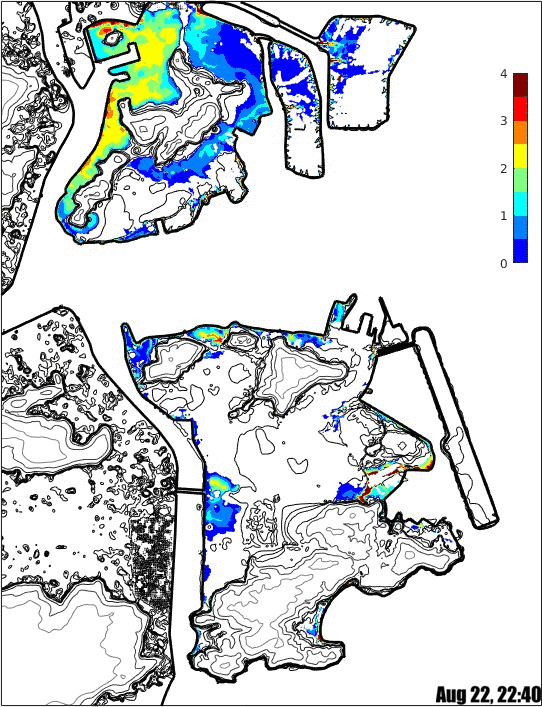
Dr. Wang's research on concurrent coastal disasters is highlighted by UNDRR.
Higuera, P., Wang, J., Hu, J., & Yang, Z. (2023). Numerical Modeling of Water Waves in Coastal and Ocean Engineering. World Scientific. doi:10.1142/13118
Wang, J., Ma, Q., Yang, Z.*, Zhang, Y., Yan, S., Zhu, S., & Li, Y. (2025). A dynamic coupling strategy for wave-WEC farm interactions: Implications on regional wave climate and wave energy deployment. Applied Energy, 399, 126440. doi:10.1016/j.apenergy.2025.126440
He, Y., Wang, J.*, He, J., Li, Y., Feng, X., & Chabchoub, A. (2025). Lifetime Characterization of Extreme Wave Localizations in Crossing Seas. Journal of Fluid Mechanics, 1008, A3. doi:10.1017/jfm.2025.155
Wang, J.* (2025). An enhanced spectral boundary integral method for modeling highly nonlinear water waves in variable depth. Journal of Computational Physics, 113525. doi:10.1016/j.jcp.2024.113525
Sou, I. M., Wang, J.*, Wu, Y. T., & Liu, P. L.-F. (2025). Laboratory investigation of turbulence scales of swash flows generated by consecutive solitary waves. Coastal Engineering, 104870. doi:10.1016/j.coastaleng.2025.104870
He, Y., Wang, J., Kibler, B., & Chabchoub, A.* (2024). Hydrodynamic modulation instability triggered by a two-wave system. Chaos, 34, 103108. doi:doi.org/10.1063/5.0220359
Wang, J., Ma, Q., Yang, Z.*, Gao, J., & Wu, G. (2022). Two types of wave-current interactions and their effects on extreme waves in directional seas. Ocean Engineering, 112637. doi:10.1016/j.oceaneng.2022.112637
Yang, Z., & Wang, J.* (2022). Linear analysis on the non-hydrostatic pressure field of depth-integrated models. Ocean Engineering, 262, 112228. doi:10.1016/j.oceaneng.2022.112228
Wang, J.*, Liu, P. L.-F. (2022). Interactions Between Dongsha Atoll and Mw 9 Tsunamis and their Impacts in South China Sea Region. Journal of Earthquake and Tsunami, 2240001. doi:10.1142/S1793431122400012
Wang, J.*, Liu, P. L.-F. (2021). A Numerical Study on Compound Impacts of Concurrent Storm Surge Tsunami Event in Macau and Hong Kong. Coastal Engineering, 170, 104000. doi:10.1016/j.coastaleng.2021.104000
Wang, J., Ma, Q. W*. & Yan, S. (2021). On Extreme Waves in Spreading Seas with Presence of Oblique Current. Applied Ocean Research, 112, 102586. doi:10.1016/j.apor.2021.102586
Wang, J., Ma, Q. W.*, Yan, S. & Liang, B. (2021). Modelling Crossing Random Seas by Fully Nonlinear Numerical Simulations. Frontiers in Physics, 9, 188. doi:10.3389/fphy.2021.593394
Liu, G., Li, X., Wang, J.*, Kou, Y. & Wang, X. (2020). Research on the Statistical Characteristics of Typhoon Frequency. Ocean Engineering, 209, 107489. doi:10.1016/j.oceaneng.2020.107489
Wang, J., Ma, Q. W.*, & Yan, S. (2018). A fully nonlinear numerical method for modeling wave current interactions. Journal of Computational Physics, 369, 173-190. doi:10.1016/j.jcp.2018.04.057
Wang, J., Ma, Q. W.*, Yan, S., & Qin, H. (2018). Numerical study on the quantitative error of the Korteweg de Vries equation for modelling random waves on large scale in shallow water. European Journal of Mechanics B/Fluids, 71, 92-102. doi:10.1016/j.euromechflu.2018.04.004
Wang, J., Ma, Q. W.*, Yan, S., & Chabchoub, A. (2018). Breather Rogue Waves in Random Seas. Physical Review Applied, 9(1), 014016. doi:10.1103/PhysRevApplied.9.014016
Wang, J., Ma, Q. W.*, & Yan, S. (2017). On quantitative errors of two simplified unsteady models for simulating unidirectional nonlinear random waves on large scale in deep sea. Physics of Fluids, 29(6), 067107. doi:10.1063/1.4989417
Wang, J., Ma, Q. W.*, & Yan, S. (2016). A hybrid model for simulating rogue waves in random seas on a large temporal and spatial scale. Journal of Computational Physics, 313, 279-309. doi:10.1016/j.jcp.2016.02.044
Wang, J., Yan, S.*, & Ma, Q. W. (2015). An improved technique to generate rogue waves in random sea. CMES Computer Modeling in Engineering and Sciences, 106(4), 263-289. doi:10.3970/cmes.2015.106.263
Wang, J., & Ma, Q. W.* (2015). Numerical techniques on improving computational efficiency of spectral boundary integral method. International Journal for Numerical Methods in Engineering, 102(10), 1638-1669. doi:10.1002/nme.4857